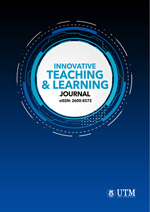An Analysis of Practicality for Google Classroom Implementation in Kelantan State Secondary Schools
DOI:
https://doi.org/10.11113/itlj.v7.139Keywords:
Google Classroom, teaching, learning, online, secondary schoolAbstract
E-learning, a contemporary technological innovation, is extensively employed in contemporary educational institutions and is recognized by educators. The utilization of information and communication technology (ICT) as an instructional mechanism constitutes an additional pioneering teaching and learning (T&L) approach. The credibility of technology must be ensured in order to effectively augment the current instructional framework. The utilization of Google Classroom as an instructional platform to supplant the conventional physical approach to learning has the potential to establish an educational setting aligned with the demands of the 21st century. The accelerated growth of Google Classroom can be attributed to its distinctive attributes, each of which contributes independently to its efficacy. This research study employs a quantitative research approach that employs a survey methodology utilizing a questionnaire to assist researchers in gathering more precise and high-quality data and information. Issues and Challenges of Using Google Classroom in PdPR are inadequacy of support and exposure, the preparedness of teachers, the preparedness of students, access to the Internet, and the availability of device tools. Several proposed resolutions can be considered in addressing this issue. These include augmenting preparedness through the provision of comprehensive teacher education, fostering cognizance among parents and guardians, fostering cooperative efforts between governmental and private entities, as well as enhancing the capabilities and infrastructure of information and communication technology (ICT) facilities. It is of utmost importance to tackle additional obstacles that emerge in the utilization of this platform in order to alter the instructional regimen. Collaboration among stakeholders in the industry is imperative to guarantee that elementary school pupils are provided with technological resources and receive assistance for remote education.

















